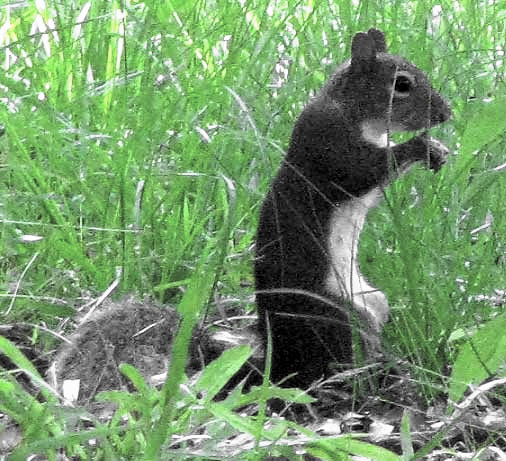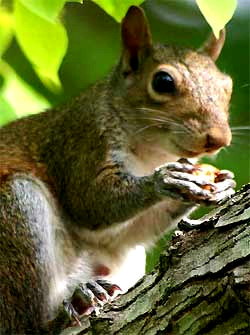Excerpts from Jim Conrad's
Naturalist Newsletter
from the May 13, 2012 Newsletter, issued from the forest near Natchez, Mississippi; elevation ~400ft (120m), ~N31.47°, ~W91.29°:
SKINNY SQUIRRELS
In late afternoon's quickly dimming light often a two or three Eastern Gray Squirrels, sometimes accompanied by a chipmunk or two, stealthily step from the forest beside my trailer and enter the orchard where they sniff and scratch until they find something to eat. You can see a squirrel at work below.

That's an awfully skinny squirrel. However, when you think about it, there's probably good reason for it. Nuts and seeds cached last fall by now may be eaten up, or hard to find, rotten or bug-eaten. Starchy underground tubers have sprouted producing watery, low-calorie shoots. The first flush of general flowering has slowed down but most plants aren't fruiting yet. There are things to eat, but not much that's calorie rich, like acorns. There are eggs and nestlings to eat, but bird parents are on high alert.
For squirrels, unless someone in the neighborhood is keeping a birdfeeder full, nowadays just isn't a good time to gain weight!
from the January 5, 2003 Newsletter, issued from near Natchez, Mississippi:
NEST BUILDING SQUIRREL This morning as I campfired my breakfast into existence an Eastern Gray Squirrel made several trips up and down the trunk of the big Pecan tree over my trailer. Down he'd come and disappear into the clutter where the other big Pecan fell during Hurricane Lili. In a minute or two he'd appear back on the trunk, this time with his mouth crammed with a clump of leaves nearly as large as his head. Up and up he'd go, to 4/5ths the tree's height. Then he'd disappear, apparently into a hole on the tree's far side, and before long he'd repeat the journey.
This morning as I campfired my breakfast into existence an Eastern Gray Squirrel made several trips up and down the trunk of the big Pecan tree over my trailer. Down he'd come and disappear into the clutter where the other big Pecan fell during Hurricane Lili. In a minute or two he'd appear back on the trunk, this time with his mouth crammed with a clump of leaves nearly as large as his head. Up and up he'd go, to 4/5ths the tree's height. Then he'd disappear, apparently into a hole on the tree's far side, and before long he'd repeat the journey.
from the January 18, 2004 Newsletter, issued from near Natchez, Mississippi:
FORAGING GRAY SQUIRRELS
Most mornings in dawn's twilight, before the sun's rays begin shooting in from the east, several Eastern Gray Squirrels, SCIURUS CAROLINENSIS, work among the slender branches at the top of oak trees in the woods. Sometimes there's five or more. Acorns cluster at the outer branches, so when a squirrel goes there, the branches yield. A squirrel's acorn-nabbing foray usually begins with a brief pause on the stable part of a branch, then there's a hurried rush to a branch- tip acorn, and then a rush back. Sometimes a squirrel misjudges a branch's strength and momentarily finds himself dangling, or worse.
If you ever see such a group of foraging squirrels, notice how each individual runs along a branch for a second or two, then freezes, then runs some more, then freezes. When several squirrels in a tree all move in this stop-motion manner, it's a funny thing to see. My guess is that they pause because it's easier for them to spot approaching hawks and owls. Seeing how all squirrels stick to such a disciplined program of stops and goes, we have a hint as to how serious the predator threat is for them.
By the time sunlight hits the treetops, the squirrels are gone. I suppose that's because the bright light makes them more vulnerable to their predators. They don't always return to their dens for the rest of the day, for often in the middle of the day I hear the "Aaarghhhh!" call that's often made by aggravated female squirrels when they're being chased by several males. These chases can go on for hours. I have a true-to-life online story, "Mistletoe: One Year in the Life of a Gray Squirrel," describing one such chase, at www.backyardnature.net/mist02.htm.
from the March 17, 2002 Newsletter, issued from near Natchez, Mississippi:
FOUR SQUIRRELS RACING
While sitting there silently and invisibly four Eastern Gray Squirrels appeared right across the pond from me, three males chasing a female. Making much more noise than usual these squirrels seemed intoxicated by their chase, hardly paying attention to where they went, and sometimes they even misjudged their leaps. But then suddenly the female stopped, all three males behind her also paused, and during the ensuing rest period a couple of the males actually looked bored. However, the lead male sniffed the branch over which the female had just passed, and his attention didn't diminish at all. He glared and flitted his tail at the female on the next branch. After about three minutes the female took off again, two males continued after her, but the last male in the group wandered away as if he couldn't care less.
Seeing this gratified me enormously. Online I present a short story called "Mistletoe: One Year in the Life of An Eastern Gray Squirrel." Before writing that story I read a lot so that the behavior of my heroine would be as close to that of a real squirrel in nature as possible. "Chapter 2, February" is subtitled "The Chase," and it describes precisely the kind of chase witnessed at the turtle pond.
Sometimes these chases go on for most of a day, and often many more males than three go after a female. Apparently such chases provide a way for females to judge which male has the most stamina, plus the chase itself appears to put unreceptive females into more romantic moods. If you'd like to read "The Chase," go to www.backyardnature.net/squirrel.htm and click on February.
On Saturday morning during breakfast I watched another squirrel make several trips up the big Pecan tree above my trailer, carrying mouthfuls of Spanish Moss for a nest.
from the May 12, 2002 Newsletter, issued from near Natchez, Mississippi:
HUNGRY SQUIRREL
Earlier this week I was sitting invisibly (unmoving) next to a woods pond when a young squirrel came near, quite oblivious to me just 15 feet away. He was sniffing and test-biting all kinds of things, the way young squirrels do when learning how to survive. Don't forget that a first-year squirrel doesn't have pecan caches from last fall to dig up.
This squirrel seemed almost frantic in his efforts to find something. He'd take last year's Honeylocust pod in his mouth, black and crumbly, and appear to be eating it, but then before swallowing he'd let the pod fall from his mouth, and then you knew that there was more hope than food in that pod. Then he found a fallen log that was a little moist on top, and crumbly. He actually bit into the soft wood, seeming to gag sometimes, maybe hoping to expose a fungus or insect larvae. But I couldn't see that he got anything. He put all kinds of things into his mouth but eventually everything was dropped again, and nothing swallowed.
Gradually it dawned on me that this can be a hungry season for squirrels. Their nuts, acorns, maple samaras, hornbeam fruits and pine nuts belong to fall, not spring. Now those fruits are either sprouted and the sprouts are charged with bitter elements that keep animals from eating them, or else they're decayed. A squirrel can eat caterpillars, cocoons, beetles and even ants, birds' eggs and nestlings in this season, but these can be hard to catch.
In a way I was chastened by this insight. I like to think that I am in tune with the animals around me, but somehow I had forgotten that though this season is good for insect-eating warblers and mulberry eaters, if you are a creature specializing in nuts and the like, these are hungry times.
The squirrel found a mushroom, nibbled it, jumped backwards and froze staring at it. Then in aggravation he barked, stamped his feet and turned and ran away violently flicking its tail.
from the August 26, 2001 Newsletter, issued from near Natchez, Mississippi:
SQUIRRELS & GREEN PECANS
Ten or so years ago the woods in which my trailer is parked was not a woods. There was an old grove of Pecan trees next to a sloping field. Now my trailer is parked beneath the remaining old Pecan trees and what earlier was a field now is occupied mostly by young Sweetgum trees 15-30 feet high. As I prepare breakfast each morning I constantly gaze into the big Pecans' limbs not only because I hope to spot interesting birds but also because the trees' spreading limbs heavy with green ferns and abundantly festooned with long gray strands of Spanish Moss are profoundly lovely to look at, especially when a breeze comes along.
Nowadays squirrels spend a lot of time high in these Pecan trees working on green pecans. Sometimes they gnaw off the nuts' green husks, causing a general rain of pecan-husk particles onto the ground below, then in their mouths the squirrels carry off the tan nut for later eating. Sometimes they appear to eat husk, shell and kernel right there in the tree. Often they drop whole nuts and I'm guessing that they do this when they pick a nut that's too hard for easy eating.
Day by day the squirrels lose their haggard summer appearance and before long they will be positively fat and glossy. And day by day the litter of green pecan particles on my trails becomes harder on my bare feet.
from the October 21, 2001 Newsletter, issued from near Natchez, Mississippi:
SQUIRRELS EATING PECANS
At the end of last year's droughty summer there were few pecans but this year, thanks to timely rains, there are plenty. A few are falling now but it'll be a while before I go gathering them. At dawn as I prepare breakfast the squirrels are very busy above my campfire. They make their way to a branch's end, stretch gingerly across the slender twigs there and pluck a pecan, husk and all. Then they withdraw back onto thicker, more stable wood, bite off the splitting husk and drop the pieces onto the ground, and then gnaw at the pecan itself as they keep an eye on me below. In August and September these squirrels looked pretty scrawny but now they are sleek and sometimes I chuckle seeing how roly-poly they've become.
The breakfast view up through the big pecan trees is delicious. Branches deliquesce gracefully away from heavy black trunks. Leaves glow warmly in morning's slanting yellow sunlight, and there's dew on them so they glisten against the blue sky. Not only squirrels animate this theater but also hungry birds -- woodpeckers, titmice, chickadees, and migrating warblers. I keep binoculars handy to see which warbler species are passing through, but they are hard to identify, being silent and wearing their drab fall plumage.
Up through this busy little world my campfire's smoke drifts like an agreeable notion filtering through a soul at peace. Once I have something hot to drink and I smell the morning's baking cornbread, I know that once more all's right with the world.